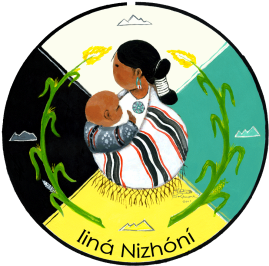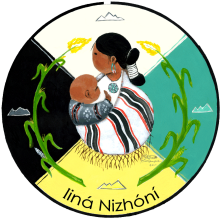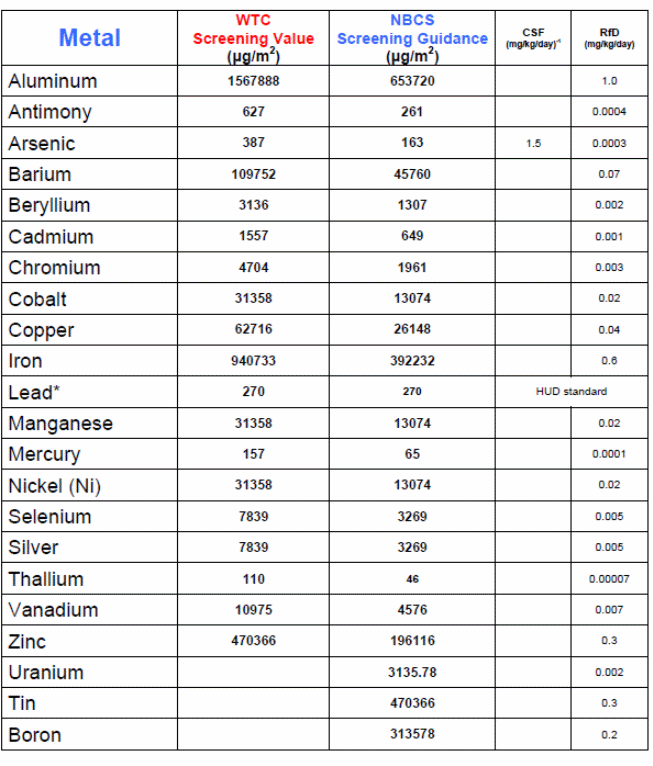Biomonitoring Report Letter
Att17 Biomn Env Home Assmnt Rprt Ltrs.docx
Prospective Birth Cohort Study Involving Environmental Uranium Exposure in the Navajo Nation
Biomonitoring Report Letter
OMB: 0923-0046
College
of Pharmacy Community Environmental Health Program MSC
09 5360 1
University of New Mexico Albuquerque,
New Mexico 87131-0001 905
Vassar NE Telephone
505.272.4087/ Fax 505.272.4186

 elping
Your Child to
elping
Your Child to
Grow in Beauty
[DATE]
[ADDRESS]
[ADDRESS]
RE: Results of Navajo Birth Cohort Study Biomonitoring – Metals in Blood and Urine
Dear [Participant Name] :
The research team from the Navajo Birth Cohort Study (NBCS) wants to thank you for participating in the study. As you know, the NBCS is studying if uranium on the Navajo Nation affects child birth and development. To fully understand uranium exposures and health, we have also analyzed other environmental chemicals that may occur on Navajo Nation.
Recently, (you/your baby) gave us a sample of blood and urine to test to see if you might be exposed to metals in your environment. In this letter, we would like to let you know about any values that we saw that are of possible concern, and a brief description of how you can reduce those exposures.
In the table below, (your/your baby’s) results are listed in the first column. To help you compare your results to what we see around the United States, the upper half of the ranges found in a nationally representative sample from the National Health and Nutrition Examination Survey (NHANES) are listed in the second column. NHANES, which is conducted by our partners at the Centers for Disease Control and Prevention, establishes ranges for these chemicals as they are typically found in people all across the United States.
Metal Measured |
Your value (µg/L) |
NHANES (50th – 95th percentile range) 1 (µg/L) |
(Arsenic - urine) |
|
N/A |
(Lead) – blood) |
|
1.34 – 3.90 |
(Uranium - urine) |
|
N/A |
(Mercury - blood) |
|
0.89 – 5.32 |
The metals reported in the table are those that are regularly tracked by public health agencies such as State Departments of Health, or those for which what we saw was higher than typically observed in NHANES or other NBCS participants. These results do not necessarily mean that you will become ill, but they do indicate a possible exposure you may be able to reduce, reducing the chance of any health effects for you or your child. Below we identify for each metal
Likely ways in which you may be exposed
What is known about health effects related to exposures
Uranium: Uranium is the primary concern of this study. It occurs in many parts of the Navajo Nation and the Colorado plateau. Mining and milling have left wastes throughout the Nation which remain as sources of exposure. Also, more than 10% unregulated of livestock wells have uranium at unsafe levels. Elevated levels of uranium are considered toxic to the kidney. The DiNEH Project, CDC, and the New Mexico Department of Health have found that urine uranium levels in the Southwest, including Navajo Nation tend to be higher than for the rest of the country as reported in NHANES.
Arsenic: In New Mexico, the Department of Health requires reporting of arsenic in urine > 50 ug/L. Arsenic is a common compound found in drinking water in the region. Arsenic is a very common contaminant in groundwater in many areas around the world, including the Navajo Nation, where unregulated ~15% of or livestock wells, exceed safe-drinking water standards. Arsenic can be associated with mining, and has also been found in natural remedies, in foods grown in arsenic-rich areas. Long-term exposure to elevated levels of arsenic is associated with skin, lung, and other cancers; skin sores, anemia, and peripheral neuropathy (numbness in hands, arms, legs and feet).
Lead: In New Mexico and Arizona, all detectable levels of blood lead are reportable. Lead exposures occur from many sources. Lead used to be used routinely in paint, and also in gasoline. Although it has been removed from gasoline for several decades, and is no longer a paint sold in the U.S. today, many houses still have old paint containing lead. When older house paint chips, it can be swallowed by children. Lead has also been used in pottery glazes, in vinyl blinds, and in other materials common in the home. Lead may be in solder used in silver smithing and other arts, crafts, and hobbies including stained glass. Finally lead is also found in mine waste materials, and is released from smelting of metals. Lead accumulates in the body, can damage the nervous system, produce anemia, and other health problems. Because children’s nervous systems are developing, exposures in children are of particular concern.
Mercury: Mercury is also a naturally occurring element, found in some coal. Coal is burned in the production of electric power as well as in home heating. Concerns have been raised about eating certain kinds of fish (e.g., tuna, mackerel, shark) because methyl mercury accumulates in predator fish. At high levels, mercury can damage the nervous system and there have been concerns that exposures to the developing fetus can produce long-term developmental delays. The New Mexico Department of Health follows mercury in blood >5 ug/L.
Studies like the NBCS are conducted to help us better understand how exposures and disease are related. It will be several years before we can tell you our results, but in the meantime, trying to reduce exposures can reduce your values and help to ensure you and your baby will remain healthy.
If you have any questions on these results, please contact our office toll free at 1-877-545-6775. Again, thank you for participating in the Navajo Birth Cohort Study.
Sincerely,

Director, Community Environmental Health Program
PI – DiNEH Project and Navajo Birth Cohort Study
N avajo
Birth Cohort Study
avajo
Birth Cohort Study
c/o Southwest Research and Information Center
P.O. Box 4524
Albuquerque, NM 87196
505-262-1862; fax: 505-262-1864
DATE
NAME
MAILING ADDRESS
CITY STATE ZIP
Dear [Participant’s Name],
Thank you for participating in the Navajo Birth Cohort Study (NBCS). This study will help the Navajo Nation determine if exposure to uranium wastes affects pregnancies and birth outcomes, and your participation makes an important contribution to that goal.
On _____________ [date], our Research Field Staff conducted a home environmental assessment at your home. Our staff member, _____________ [name] shared with you preliminary results of the assessment. I am writing to report all assessment results to date and to indicate whether any of these results require making a referral to the Navajo Nation Environmental Protection Agency (NNEPA) for additional assessments and follow-up.
Gamma Radiation Assessment:
Average outdoor exposure rate: ______ µR/hr (microroentgens per hour)
Maximum outdoor exposure rate: ______ µR/hr
Average indoor exposure rate: ______ µR/hr
Maximum outdoor exposure rate: ______ µR/hr
Background exposure rate: ______ µR/hr
Investigation level rate: ______ µR/hr ___ 2x background ___ SD method
Referral to NNEPA ______ Yes ______ No
Reason(s) for referral: NBCS is referring you to NNEPA for further gamma radiation assessments because the maximum outdoor exposure rate exceeded the investigation level.
This result indicates that gamma radiation levels are higher than what would be considered “normal” or “natural”. In your case, the magnitude of the excess radiation necessitates follow-up by NNEPA as soon as possible. In the meantime, NBCS recommends that you and your family members AVOID or LIMIT your presence in ____________ [PLACE WHERE EXCESS LEVELS WERE FOUND]. Children are particularly susceptible to the adverse effects of exposure to elevated gamma radiation levels, and NBCS recommends that your children STAY OUT or AVOID _______________ [place].
Radon Gas Assessment:
Date Canister Placed: __________________ Date Canister Retrieved: _______________
Radon concentration: _____ picocuries per liter-air (pCi/L)
NBCS/NNEPA action level: 2.7 pCi/L-air
Referral to NNEPA ______ Yes ______ No
Reason(s) for referral: NBCS is referring you to NNEPA for further indoor radon testing because the average radon level during the __-day test period exceed the “action level” of 2.7 pCi/L. NNEPA will contact you for further testing. In the meantime, we recommend that you keep your home well ventilated.
Dust Wipe Samples for Heavy Metals:
Sample #1 [LOCATION IN HOME]
Sample #2 [LOCATION IN HOME]
Sample #3 [LOCATION IN HOME]
Sample #4 [LOCATION IN HOME] (if collected)
These dust samples were tested for 22 metals. The following metals were detected in concentrations exceeding reference values (See attached for NBCS screening guidance table):
Metal |
Concentration |
NBCS Screening Guidance |
|
|
|
|
|
|
Referral to NNEPA ______ Yes ______ No
Reason(s) for referral: NBCS is referring you to NNEPA for further dust testing in your home. For the metals that were detected in excess of the Screening Guidance, I have attached information about the potential health effects of these metals and recommendations for reducing their presence in your home. Generally, NBCS recommends regular cleaning to reduce dust and dirt from accumulating in your home.
Hydrogen Sulfide Monitoring:
Period of Testing: Started _____________ [DATE] Stopped ____________ [DATE]
Average Hydrogen Sulfide concentration: ______ parts per million (ppm)
Maximum Hydrogen Sulfide concentration: ______ ppm
NBCS Action Level: ______ ppm
Referral to NNEPA ______ Yes ______ No
Reason(s) for referral: NBCS is referring you to NNEPA for further hydrogen sulfide testing in your home because the average/maximum level detected during the 30-day sampling period exceeds the study action level. Prolonged exposure to this level of hydrogen sulfide may cause _________________________________________________________________ [FILL IN HEALTH EFFECT, BASED ON LEVEL REPORTED]. I have attached a chart that shows the range of long-term (or chronic) and short-term (or, acute) health problems that may result from hydrogen sulfide exposure.
Water Quality Testing of Unregulated Well(s):
In the intake survey, you identified the following water sources as your sources of drinking water:
Water Source or Well Name or Number |
Type of Source: Regulated or Unregulated |
[LIST PWS FIRST] |
|
|
|
|
|
|
|
Regulated drinking water is piped to your home through the Navajo Tribal Utility Authority (NTUA) public water supply system. To demonstrate compliance with NNEPA and USEPA drinking water standards, NTUA is required to test and treat the water it delivers. Tests are conducted monthly for bacteria that, if present, may be immediately harmful to your health and the health of your family.
Bacteriological Tests: Fecal coliforms: Present Not Present
E coli Present Not Present
NTUA periodically tests for radioactive substances, heavy metals, pesticides, solvents and other contaminants. Contaminants found to exceed drinking water standards in the most recent tests, and their concentrations, are listed in the table below.]
For the unregulated water sources you listed, we did not find existing water quality data. To assess water quality in these sources, we conducted field tests and collected samples on ___________________. These samples were tested at the USEPA laboratory in Richmond, California. Contaminants that exceeded either Maximum Contaminant Levels (MCLs) or Secondary Drinking Water Standards (SDWSs) are shown in the following table. (We used drinking water standards for comparison purposes only; these standards do not apply to private and other unregulated water sources.) A copy of the laboratory analytical results is attached to this letter.
Water source ID |
Contaminants Exceeding MCL |
Contaminant Concentrations |
MCLs |
Contaminants Exceeding SDWS |
Contaminant Concentrations |
SDWSs |
Use rec’d |
|
|
|
|
|
|
|
|
|
|
|
|
|
|
|
|
|
|
|
|
|
|
|
|
|
|
|
|
|
|
|
|
Use recommendations shown in the column on the far right are based on the laboratory results shown in the table above. We recommend “no use” for any water source that has 1 or more exceedances of an MCL. For unregulated water sources that do not exceed an MCL, we recommend “caution” in using this water source for drinking. Navajo Nation policy is that unregulated, livestock-use-only water sources should not be used for human drinking water.
Please don’t hesitate to call me at 505-262-1862 if you would like further explanation of these results. You may also call the NBCS Principal Investigator, Dr. Johnnye Lewis, at 505-272-4853. If you desire to speak in the Navajo language with one of our field staff, please call any one of them at the numbers below.
David Begay, Ft. Defiance-Ganado-Chinle area, 928-607-0365
Lynda Lasiloo, Shiprock/North Central area, 505-686-1060
Teddy Nez, Gallup-Ft. Defiance area, 505-879-6604
Cora Maxx Phillips, Tuba City/Western area, 480-452-7480
Sandy Ramone, Gallup/Eastern Agency area, 505-801-9040
Again, we thank you for participating in the Navajo Birth Cohort Study.
Sincerely,
Chris Shuey, MPH
Co-investigator
Navajo Birth Cohort Study
Screening Guidance for Metal Dust Samples

1 The reference values are found in adults (20 years and older) as reported by the National Health and Nutrition Examination Survey (NHANES) conducted by the Centers for Disease Control and Prevention (values are subject to change per survey data availability). Arsenic and Uranium levels were not included since these values may not be representative of areas in the Southwest that have higher levels of naturally occurring uranium.
| File Type | application/vnd.openxmlformats-officedocument.wordprocessingml.document |
| File Title | Navajo Birth Cohort Study |
| Author | Chris Shuey |
| File Modified | 0000-00-00 |
| File Created | 2021-01-24 |
© 2025 OMB.report | Privacy Policy